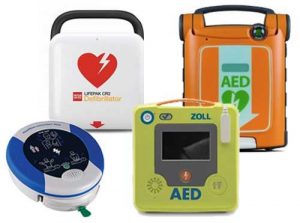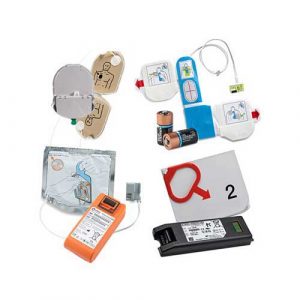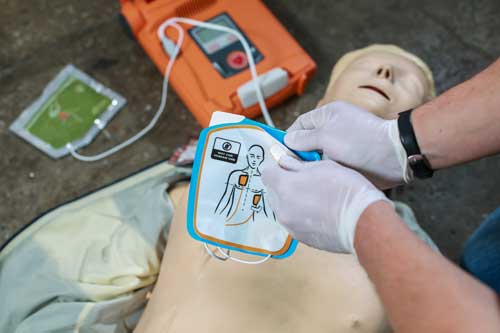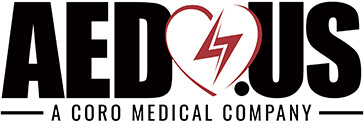 Whether you are required to have an AED, or make the voluntary decision to have one, once you have an AED, it is important to manage your AED and ensure compliance with any federal, state or local ordinances. These requirements vary from state to state. At a minimum, the federal government and each state require that you purchase an FDA-Approved AED and that you follow the manufacturer’s recommendations. These recommendations are specific to each make and model and typically include routine inspections and replacement of pads (electrodes) and batteries.
Whether you are required to have an AED, or make the voluntary decision to have one, once you have an AED, it is important to manage your AED and ensure compliance with any federal, state or local ordinances. These requirements vary from state to state. At a minimum, the federal government and each state require that you purchase an FDA-Approved AED and that you follow the manufacturer’s recommendations. These recommendations are specific to each make and model and typically include routine inspections and replacement of pads (electrodes) and batteries.
- Manage your AED
- CPR/AED Training
- Medical Direction and Physician Oversight
- Emergency Response Plan
- AED Storage
- AED Warranties
- CPR Feedback
- Remote Monitoring
- AED Program Management
Manage your AED:
Most AEDs do an internal self-check on a regular basis, and the inspections ensure no issues are found during the internal checks and that pads and batteries are not expired. These self-checks vary, with some AEDs checking the presence of pads and batteries and others going so far as to test the functionality of the pads. It is recommended to keep written logs that you are following these recommendations so you can document compliance.
AED Pads and Batteries
 AED pads usually have an expiration date on the packaging. It is crucial to replace them before the expiration date. Once the expiration date has passed, you are at risk of the electrodes drying out, and then they will not work when needed. Similarly, nothing is worse than being in a situation where an AED is needed and finding out the battery is dead. Most electrodes are on a 2-year replacement cycle, with batteries on a 4-year replacement cycle. Some AEDs have high-capacity batteries that can last up to 7 years. Because these timeframes vary and are spread out, it is vital to have a tracking system in place to stay on top of the expiration dates and plan for and forecast needed replacement parts to replace the products before they expire. Supply chain challenges can make it difficult to secure products when needed, so it is essential to be aware of and plan for replacements in advance.
AED pads usually have an expiration date on the packaging. It is crucial to replace them before the expiration date. Once the expiration date has passed, you are at risk of the electrodes drying out, and then they will not work when needed. Similarly, nothing is worse than being in a situation where an AED is needed and finding out the battery is dead. Most electrodes are on a 2-year replacement cycle, with batteries on a 4-year replacement cycle. Some AEDs have high-capacity batteries that can last up to 7 years. Because these timeframes vary and are spread out, it is vital to have a tracking system in place to stay on top of the expiration dates and plan for and forecast needed replacement parts to replace the products before they expire. Supply chain challenges can make it difficult to secure products when needed, so it is essential to be aware of and plan for replacements in advance.
The process of replacing your pads or battery is always simple, with a click-and-plug type toggle, similar to many other plugs and/or batteries that you have used before. Generally, pads can be disposed of in the garbage. At the same time, batteries should be recycled at an approved facility. Recycling can be done through local municipalities or anywhere that can recycle computer equipment.
AED/CPR Rescue Kit
Another item that should be stored with the AED is a rescue or CPR Kit, a small, zippered pouch that typically includes
- (1) face mask
- (1) scissors
- (1) razor
- (1 pair) gloves
- (1) towelette or absorbent wipe
This, too, should be part of the inspection process as many face masks have printed expiration dates, and if not replaced, the plastic the mask is made with may degrade, develop a sticky feel and stop working as intended. These kits are often overlooked but are inexpensive to replace and an essential part of maintaining your AED correctly.
CPR/AED Training:

While the Good Samaritan Act generally covers the user of an AED, whether trained or untrained, CPR/AED training is a requirement in some states, and even if it’s not required, CPR and AED training are highly recommended. This should be done through a certified entity such as The American Heart Association, American Red Cross, or National Safety Council. This training is a certification that needs to be renewed every two years. The more people are trained, the more confident they will be during a rescue situation which will increase the odds of a successful save. CPR/AED is the basic training needed; however, many choose to include First Aid Training and Bloodborne Pathogen Training. Learn more about our nationally-recognized AED/CPR training.
Medical Direction and Physician Oversight:
Some states also require that you have “medical direction”. This involves having a licensed doctor that oversees your AED program, ensuring you comply with state and local laws, your equipment and training are up to date, and all required paperwork and associated filing is completed, if necessary. The paperwork can be different for each state but can include copies of an Emergency Response Plan, Notification of placement of your AED, and more.
Emergency Response Plan:
It is recommended to have an Emergency Response Plan that can be incorporated into internal policies and procedures. One helpful tip is to include AED Drills, with the intent to help staff to be more prepared to respond in the event an AED is used. The response plan should also detail what happens if and when you need to use your AED. Medical direction can remove any stress you may have after a cardiac event where the AED is used. Each AED has a way to download the data from the incident, including the record of the heart’s rhythm, delivery of shocks, and other vital information needed for a treating physician via internal software. This data can be accessed via USB, infrared reader, data cable, or Wi-Fi, depending on the device. Once the data is downloaded, the treating physician will review the information, file any reports as required, and review the response to provide feedback if any retraining is needed. After the AED is used, the pads will need to be replaced. Another recommended best practice is to keep a spare set of electrodes on hand, so there is no delay in having the equipment ready for use again after an event.
AED Storage:
AED Equipment should be stored in a temperature-controlled environment as lithium batteries can crack in freezing temperatures, and overheating the batteries can cause the batteries to deteriorate earlier than expected. In addition, many AEDs have safety measures where the device will go into a warning mode when the temperature is outside the normal range, similar to how a smartphone will give a temperature warning and turn off until it returns to the normal range. There are a variety of cabinets available for proper storage, and many come with strobes and alarms, which not only help to alert bystanders that an emergency is occurring but also act as a theft deterrent in public settings such as schools and gyms. It is recommended to always keep the AED in the same location so it is readily accessible, and having signs to alert bystanders as to the location is recommended and, in some cases, required. If you’re at a facility that uses an AED for travel events, such as youth sports events and church outings, consider acquiring a second AED to use for these events. Getting to the AED and returning to the victim in a timely manner is most important as the stats show the likelihood of a successful rescue is increased dramatically if CPR is started within three minutes. To achieve the ideal response time, AEDs should be placed no more than 90 seconds away each way so that a rescuer can return to the scene with an AED to use in less than 180 seconds (3 minutes).
AED Warranties:
Lastly, all AEDS come with a warranty. Once an AED passes its warranty period, it is essential to look at a possible replacement AED. Technological advancements and American Heart Association (AHA) Guideline Updates are critical factors for replacement considerations. The American Heart Association currently provides guidance related to CPR and AED protocol that is used in AED Software, and the AHA provides updates to those guidelines every five years. When these updates are made, the AED Manufacturers are required to develop software upgrades as indicated. These upgrades must be performed on the AED to ensure it is up to date and ready to perform if needed. Additionally, as manufacturers discontinue specific models, the replacement parts may become difficult to find and eventually obsolete. Remember, trade-in options are often available for upgrades to newer AED models.
CPR Feedback:
CPR Feedback is when an AED not only provides CPR instruction but will also correct the user’s actions to ensure quality CPR is being performed. AEDs that offer CPR feedback will correct the user with audible and visual prompts to push faster, push slower, push harder, push softer, and allow the chest to recoil. Only ZOLL, Cardiac Science, and HeartSine models currently offer versions of CPR Feedback.
Remote Monitoring:
Remote Monitoring Services is a new technology that allows for inspections to be completed with notifications/alerts pushed to the person assigned to do the checks. Some AEDs offer built-in remote monitoring through the use of Wi-Fi connectivity. Some cabinet manufacturers have created remote monitoring solutions that utilize cellular data and work with various AED makes and models. Remote monitoring provides your AED with 24/7 oversight and can even go so far as to send a text alert when your AED is moved, or a cabinet is opened.
AED Program Management:
AED Program Management is an all-in-one solution to track, maintain and ensure readiness for all of the AEDs in your deployment. AED Program Management also helps track who is trained in your organization and who needs training and keeps you in compliance with federal, state, and local regulations. For larger organizations with multiple locations in different states, it is helpful to have program management to help with managing your AED program to ensure all recommendations are being adhered to.
If you have any questions about how to manage your AED, please give us a call at 800-695-1209, and our knowledgeable customer service representatives will be happy to assist you today!
 Written by Blaire Kingsmore
Written by Blaire Kingsmore
Customer Service Director
Blaire attended the University of Tennessee where she graduated with a Bachelor of Science in Human Ecology- Child and Family Studies. She has been in the Automated External Defibrillator (AED) industry for over eight years and is the Director of Customer Service for Coro Medical. Blaire is also an American Red Cross certified CPR/AED/First Aid Instructor, highly trained by each manufacturer on their specific AEDs, and knowledgeable regarding ALL State AED regulations and legislation.“I know that every day I come to work, I am playing a part in saving someone’s life. I am passionate about these devices and am always looking for new and innovative ways to spread awareness and knowledge about Sudden Cardiac Arrest (SCA). I look forward to the day when everywhere I go, I will see an AED—when SCA will no longer take any lives.”
Last updated Jan 10, 2023





